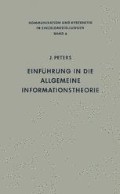Zusammenfassung
Den Überlegungen zur Wahrscheinlichkeit in § 12 war ein System zugrundegelegt worden, das auf ein bestimmtes Ereignis A mit einem Ergebnis B i aus der Menge (B) von möglichen Ergebnissen antwortet. Welches Ergebnis ausgewählt wird, ist für den Beobachter entweder grundsätzlich (bei physikalischen Mikroprozessen oder bei Zufallsmechanismen) oder aber aus Mangel an Wissen eine Entscheidung des Zufalls. In der Vorstellung der Informationstheorie1 erzeugt diese Entscheidung des Zufalls eine Information; dem Beobachter wird diese Information in dem Augenblick zugeführt, wo er diese Entscheidung unmißverständlich sicher erfährt. (Später werden auch unsichere Mitteilungen einbezogen werden, s. § 51.)
Access this chapter
Tax calculation will be finalised at checkout
Purchases are for personal use only
Preview
Unable to display preview. Download preview PDF.
Literatur
Shannon, C. E.: The Mathematical Theory of Communication. Urbana: The University of Illinois Press 1949.
Dies wird im allgemeinen die Häufigkeit (also doch!) sein. (S. § 23.)
Shannon, C. E.: The Mathematical Theory of Communication. 20. 9. Aufl. Urbana: The Unversity of Illinois Press 1962. »Quantities of the form\( H = - \Sigma {p_i} \) log p i (the constant K only amounts to a choice of a unit of measure) play a central role in information theory as measures of information, choice and uncertainty. The form of H will be recognized as defined in certain formulas of statistical mechanics where p i is the probability of a system being in cell i of its phase space.«
Duschek, A.: Vorlesungen über höhere Mathematik. III, 226. Wien: Springer 1953.
Duschek, A.: Vorlesungen über höhere Mathematik. II, 138. Wien: Springer 1950.
Siehe auch: Goldman, S.: Information Theory. 2. Aufl. 131. New York: Prentice Hall 1954.
Das Fischer-Lexikon: Sprachen. 56. Frankfurt: Fischer-Bücherei 1961.
Auch diese Bezeichnung ist nicht logisch, denn es handelt sich wieder um den Erwartungswert einer Information, also um eine Entropie. H. Piloty schlägt deshalb für diesen Begriff die Bezeichnung: Synentropie vor.
Berger, E. R.: Nachrichtentheorie und Codierung in: Steinbuch, K.: Taschenbuch der Nachrichtenverarbeitung. Berlin-Göttingen-Heidelberg: Springer 1962.
Shannon, O. E.: The Mathematical Theory of Communication, 9. Aufl. 38. Urbana: The University of Illinois Press 1962.
Fano, R. M.: Transmission of Information. 138. New York: MIT-Press 1961.
Shannon läßt in seinem Buch The Mathematical of Communication Urbana, 9. Aufl. 1962, S. 39 auch das Gleichheitszeichen in H ≦C zu. Wie der Beweis zeigt, muß dies ein Irrtum sein.
Shannon, C. E.: The Mathematical Theory of Communication. 9 Aufl. 40. Urbana: The University of Illinois Press 1962.
Elias, P.: Coding and Decoding. 324. in: Baghdady, E. J.: Lectures on Communication System Theory. New York: McGraw-Hill 1961
Die folgende Liste nennt nur einige Beispiele: Baghdady, E. J.: Lectures on Communication Systems Theory. New York: McGraw-Hill 1961.
Hoffmann, W.: Digitale Informationswandler. Braunschweig: Friedr. Vieweg & Sohn 1962.
Steinbuch, K.: Taschenbuch der Nachrichtenverarbeitung. Berlin-Göttingen-Heidelberg: Springer 1962.
Wolfowitz, J.: Coding Theorems of Information Theory. I. Aufl. Berlin-Göttingen-Heidelberg-New York: Springer 1961.
Z. B.: Richards, R. K.: Arithmetic Operations in Digital Computers. 7. Aufl. Princeton: Van Nostrand 1958.
Author information
Authors and Affiliations
Rights and permissions
Copyright information
© 1967 Springer-Verlag Berlin · Heidelberg
About this chapter
Cite this chapter
Peters, J. (1967). Grundlagen der Informationstheorie. In: Einführung in die allgemeine Informationstheorie. Kommunikation und Kybernetik in Einzeldarstellungen, vol 6. Springer, Berlin, Heidelberg. https://doi.org/10.1007/978-3-642-86500-8_5
Download citation
DOI: https://doi.org/10.1007/978-3-642-86500-8_5
Publisher Name: Springer, Berlin, Heidelberg
Print ISBN: 978-3-642-49098-9
Online ISBN: 978-3-642-86500-8
eBook Packages: Springer Book Archive

